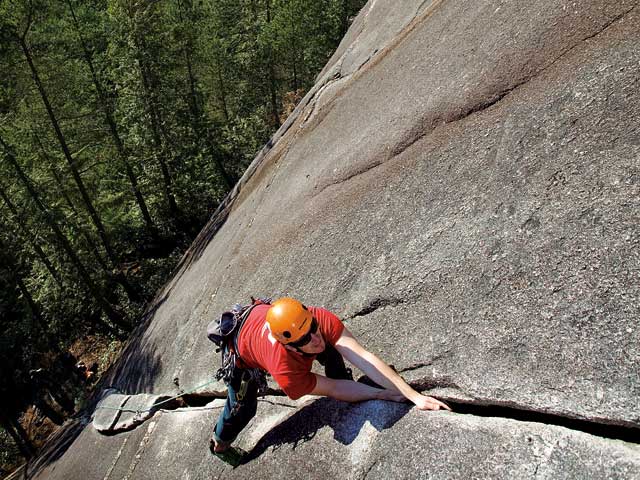From the Archives: Squamish’s Hidden Classics
The excellent rock at Squamish attracts climbers from all over the world. An influx of visitors during the peak season, often results in crowded routes. You still can find many uncrowded and lightly travelled classic routes. This is my top ten of Squamish's hidden but classic lines
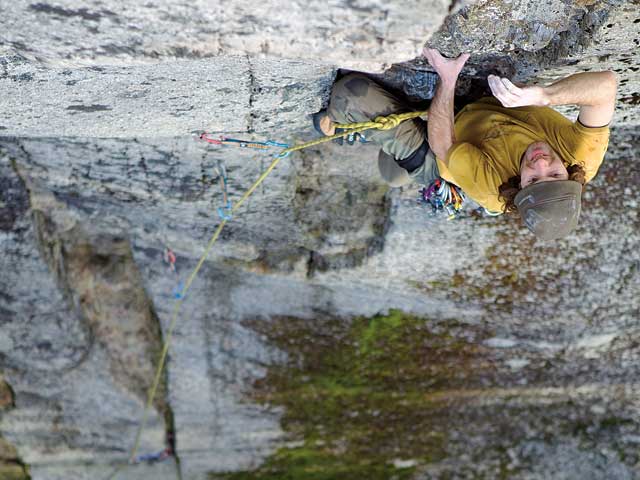
Jenny Randall is a Squamish-based climber and this piece was published in Gripped magazine in 2010.
It isn’t surprising that the excellent rock at Squamish attracts climbers from all over the world. Unfortunately, this influx of visitors during the peak season often results in crowded routes and full parking lots. If you’re visiting Squamish this summer or even if you are a long-time local, you still can find many uncrowded and lightly traveled classic routes. While some of these lines require a pleasant 40 minute hike, most are much closer to the trailhead.
These classic routes are often hidden from view just behind a clump of trees, unrecorded in a guidebook or missed for the simple fact that it takes a little more exploration to find them. This is my top 10 of Squamish’s hidden but classic lines.
Slot Machine 5.9, Bulletheads South
FA Bob Milward, Jim Campbell in 1983
Located directly above the Chief campground, Slot Machine may be one of the most accessible routes in Squamish. This fast-drying route starts just at the top of the first fixed rope in the south Bulletheads area and offers ultra-classic splitter hand crack climbing.
The reason it sees so little traffic is because routes in this area start from the tops of gullies and from traversing ledges. This minimizes the crowding but also requires more exploration to find the route. Slot Machine, once found, offers amazing jamming with crux 5.9 moves at the start. The difficulties ease-off as height is gained during the route’s two pitches. Make sure to peer over the surrounding arêtes for more gems hiding in the hanging forest.
Garret Schumacher on Slot Machine, 5.9. Photo Chris Christie
Chasing Rainbows 5.10d, Mirkwood Forest, Lower Malamute
FA John Howe, Randy Atkinson, Paul Kindree in 1979
Overhanging rock and big friendly jugs are hard to find in Squamish but amazingly, this route combines both. Chasing Rainbows is the dyke that splits the Malamute and becomes the Black Dyke on the Chief above. While most of this 28m route is bolted, climbers should bring a few small to medium cams for the crux.

You can’t see this route from the tracks. Get to it via an approach pitch or a traverse from the left. This is an obvious line that splits an impressive blank granite wall. Rappel from chains on top or search through the ledges and trees above for more pitches to climb.
Garfield 5.7, Comic Rocks
FA Bob Milward, Jim Campbell in 1983
The best 5.7 crack in the Sea to Sky corridor is located at the very first crag you reach in the Squamish area while driving north from Vancouver. To get to Comic Rocks from Squamish you will need to u-turn in Furry Creek to pass the concrete median. Then drive just past the top of the hill, heading north to a turn out with an orange gate and a small slab with a crack through it.
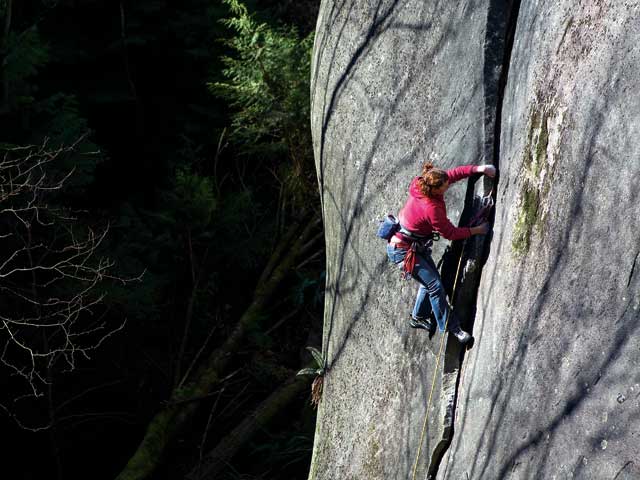
Hike past the gate for five minutes until you see a severely overhanging wall with a fantastic 5.12b crack named Vargas Girl. Just to the right is Garfield. This super-classic flake traverses the exposed, overhanging lip to a perfect hand crack which splits the wall to the summit. The rock here is magic – fine-grained crystals of granite with excellent friction.
Jingus the Cat 5.10b, Grand Wall Base
FA Scott Young, Jacquie Beaubien in 1986
The base of the Grand Wall may have the best concentration of classic single pitch 5.10 cracks in Squamish. Jingus the Cat is one of these lines. An obvious right-facing corner finger crack, the route lies on the far left base of the Grand Wall, past Seasoned in the Sun 5.10a.

If you have already ascended the hill to climb the amazing Seasoned in the Sun route then it’s only a flat hike over to Jingus. The also happens to be the intro to the classic seven-pitch Never-Never Land 5.12a
Silver Surfer 5.11c, Quartz Pillar
FA Nick Jones in 1992
Silver Surfer ascends a white pillar of granite that rises directly from the sea and offers some of the most scenic views of the Howe Sound. The route begins from a ledge just above sea level, which is easily accessed by a trail leading down from the railroad tracks beside the wall. Silver Surfer is a hard sport route which also requires a few small pieces of gear.
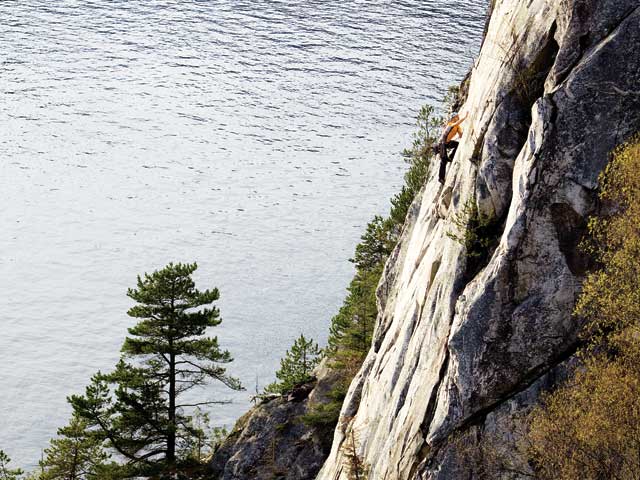
The climbing is adventurous and drifts back and forth up the white smooth face. To find this remarkable crag, park at the turn-out halfway down the hill before Britannia Beach while heading south. Walk back up the highway to the first rock feature on the ocean side.
Continue past this feature to a road sign on the northbound lane with the AM radio numbers and then drop down a talus slope from here. Just inside the forest, follow an obvious trail down to the railroad tracks and a train tunnel. Now hike north for 20 minutes until you reach another tunnel – good luck.
Asleep At the Wheel 5.8, Split Beaver, Smoke Bluffs
FA Dave Jones, Ken Neubauer in 1989
One of the best 5.8 crack routes in Squamish, Asleep at the Wheel climbs to the right of the menacing Split Beaver offwidth and has been recently reclaimed from the ever-growing Squamish moss and lichen. This wall is located right from the top of the stairs near Pixie Corner.
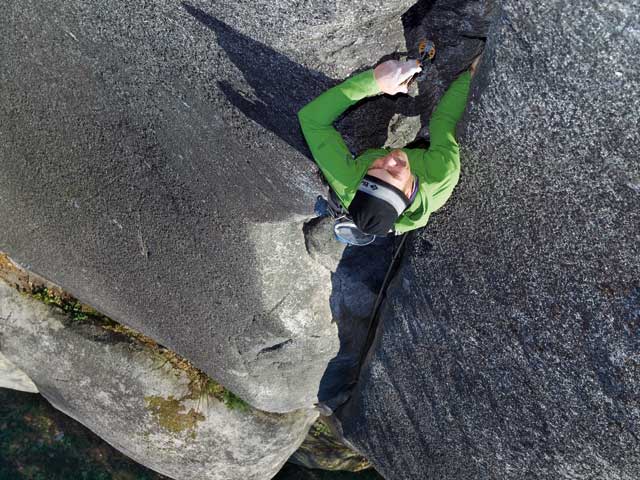
A classic traditional route, Asleep at the Wheel climbs a deep offwidth-looking flare with bomber hand jams in the back. More splitter hands lead to the summit making for a long, full value experience. It is worth spending some time exploring the bluffs, as many of newly cleaned routes and FAs are not in the guide book.
Just Blessed 5.10c, Pillar of Payan, Valley of Shaddai
FA Glenn Payan, Jeff Thomson, John Thompson in 1997
The Valley of Shaddai remains one of the least visited places in Squamish. This hidden fairyland is located above Murrin Park on the west side of the highway and requires about 30 minute approach. Huge old growth trees stand proud between the vertical walls that run the length of this tight mossy gap.
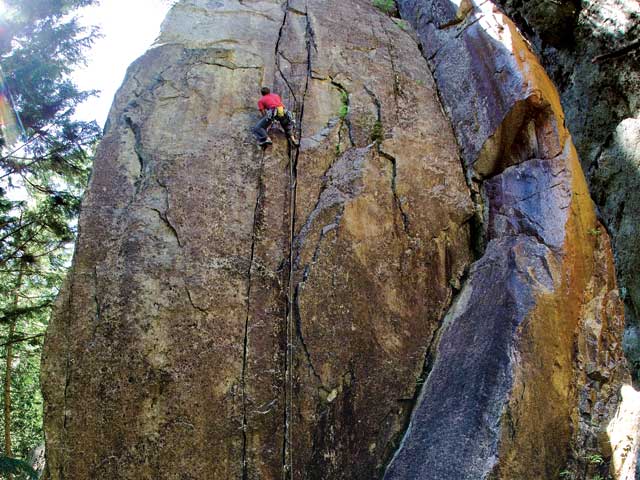
Just Blessed ascends a steep finger and hand crack up a flat vertical face. Luckily, the wall is punctuated with good footholds making this imposing wall climbable. Kevin McLane’s guide gives this route three stars but I have yet to meet anyone actually climbing this fantastic route.
The incredible Zap Crack 5.12d also lives here and sports one of the few Indian Creek-like finger and hand splitter cracks in Squamish. Even if you never plan on climbing this route it is worth just having a look at its grandeur.
Joe’s Dyke 5.7, Raven’s Castle, First Summit on the Chief
FA Joe Turley, Jim Sinclair in 1978
This may be the very best 5.7 sport climb in Squamish and as a bonus, its two pitches long. Raven’s Castle is located at the very summit of the first peak. You can either rappel off the bald summit slab from various bolted anchors or walk around before the start of these exposed slabs.

Joe’s Dyke traverses the entire wall from left to right. The wall begins as a slab and gets steeper as you go, finishing in an exposed position with a fantastic view of Howe Sound. This route makes for a fine finish to the Squamish Buttress 5.10c and can be linked into 15 pitches of climbing. There are another eight climbs here ranging from 5.4 to 5.10d, making it worth the 40 minute hike.
The Gift 5.7, High Cliff, Smoke Bluffs
FA Jack Hughes, M. Parker in 2008
A new classic 5.7 in the Smoke Bluffs – could it be true? Located below Burgers and Fries is High Cliff, a secluded wall hidden by tall trees at the end of the Blind Channel trail. The Gift was the discovered by Jack Hughes who saw the potential under the moss.
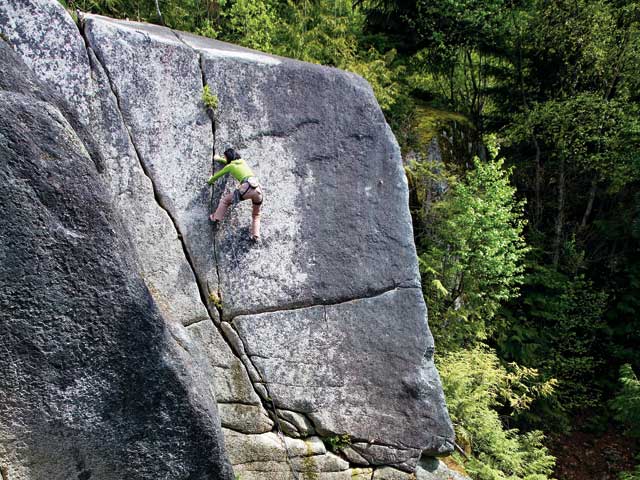
His route is located between the Twenty Minute Workout 5.10b and Convolutions of Felicia 5.10c and works its way up the wall between on the various cracks. Usually new routes are squeezed between established lines but The Gift offers an original and separate adventure. A hard start on the right begins in a hand crack and then zigzags along various fissures. Near the top you can choose between the finger or hand crack to finish. A great addition to an already fun cliff.
La Coalition 5.11+, South Gully, The Chief
FA Damien Cote, Adam Hart in 2008
Deep in the south gully, near the first vertical step is a six-pitch route that offers amazing climbing and two unique pitches. Discovered from a vantage point on Rock On and climbed ground-up, the first ascensionists didn’t know what they had until they were well into the route.

La Coalition became a group effort to scrub, bolt and free. The very dirty starting ramp keeps crowds away and may give the wrong impression to anyone seeing the route for the first time, but once into the second pitch, the climbing shines. The classic third pitch pulls out a dramatic roof at a moderate grade of 5.10c. From here, climbers encounter a strenuous endurance pitch in a very long, left-facing corner.
Few new routes in Squamish can boast such a brilliant traditional corner crack in the 5.11 range – classic.
How My Dad Saved the Smoke Bluffs
When I was one year old in 1984, my dad, John Randall helped save The Smoke Bluffs in Squamish.
At that point in his life, my dad was forty, an accountant, husband and father of three, wilderness enthusiast and President of the Federation of Mountain Clubs of British Columbia (FMCBC). It ran climbing courses (Peter Croft was an instructor), lobbied for conservation and access rights, built paths and fought to protect British Columbia’s mountain wilderness.
Jim Rutter, manager of the FMCBC, discovered that the Smoke Bluffs were to be bought by a property developer and closed to the public for good. Unfortunately, the FMCBC didn’t have the money to purchase the bluffs. After some discussion, there was a pause as Dad tallied up his life savings then said, “Tell them I’ll offer $70,000.” And to their surprise the offer was accepted. Suddenly The Smoke Bluffs belonged to Mr. John Randall and were safe.
But Mr. and Mrs. Randall weren’t in a financial position to purchase crags willy-nilly. My Dad’s actions gave the FMCBC time to act, and it agreed to purchase the bluffs from Dad. With Jim Rutter’s efforts in securing a loan from The Mountain Equipment Co-op, the Smoke Bluffs became the property of the Federation, who quickly put fundraising schemes into motion to permanently secure the area.
